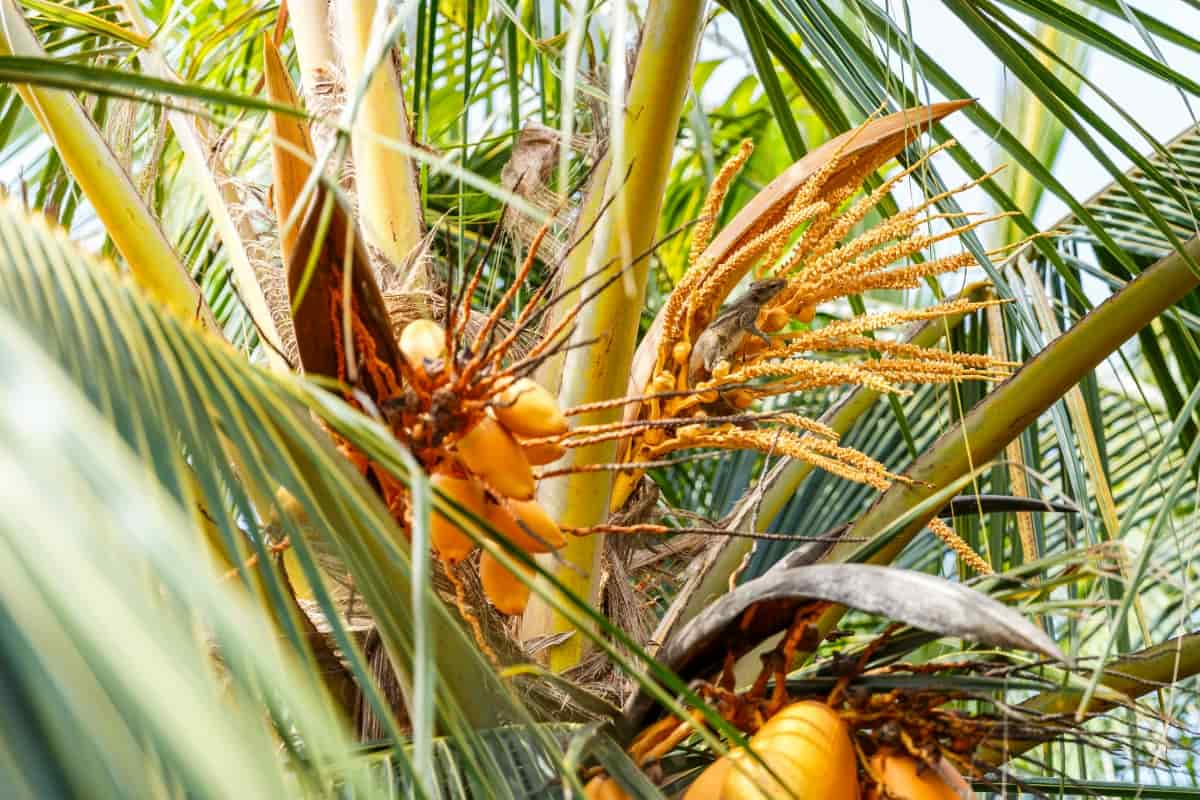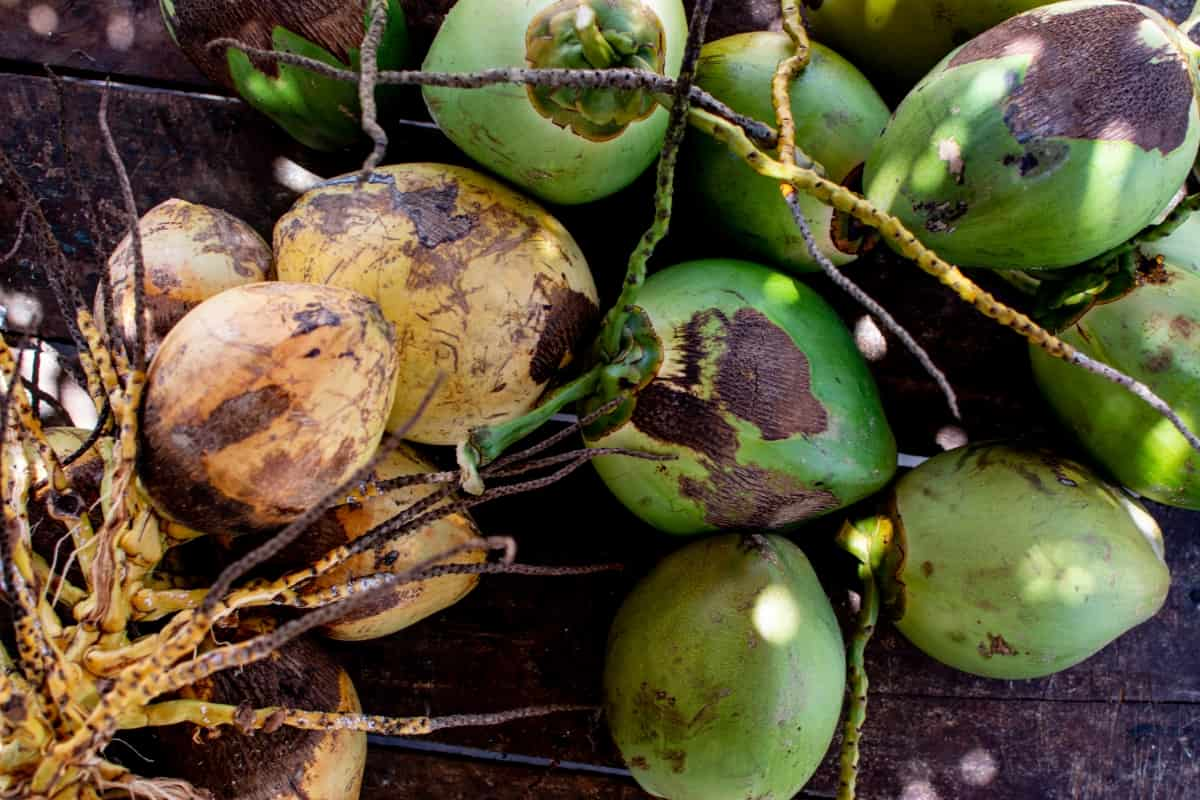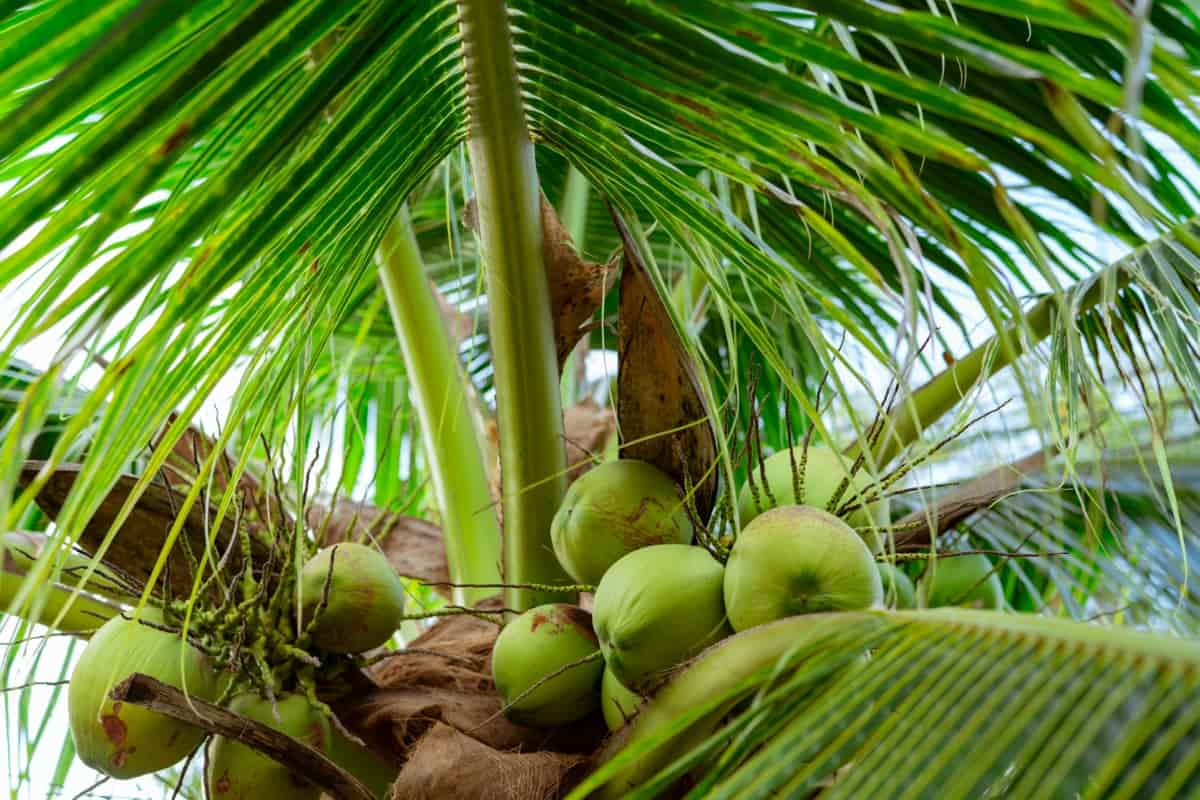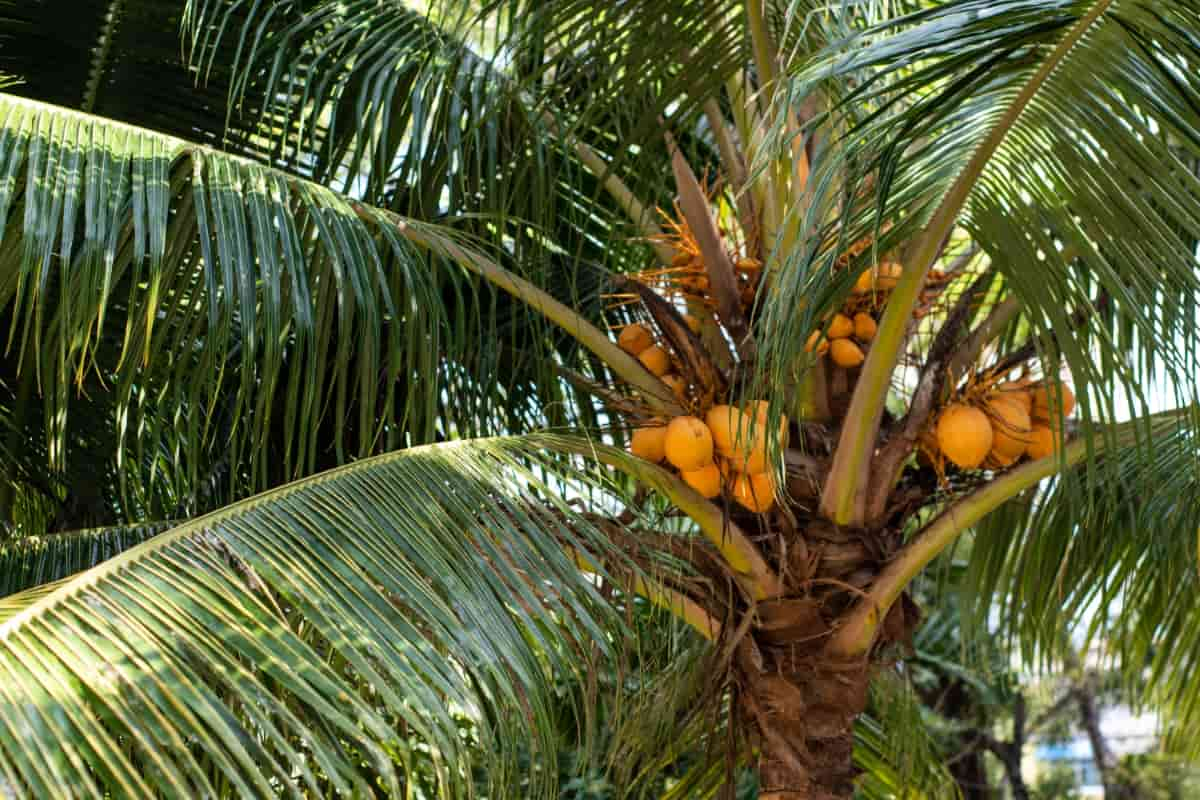Premature Coconut Dropping can significantly impact coconut yield and stability, leading to financial losses for growers. Fortunately, there are effective solutions available to Stop Coconut Button Shedding and prevent early drop. In this blog, we’ll explore various strategies and techniques to address coconut-dropping challenges and enhance coconut retention.

How to Stop Premature Coconut Dropping
Understanding Button Shedding
Button shedding, or premature coconut dropping, occurs when coconuts detach from the tree before reaching maturity. This can happen due to numerous factors, including physiological stress, environmental conditions, and nutrient deficiencies. It’s essential to understand the mechanisms behind button shedding to prevent it effectively.
Causes of Premature Coconut Dropping
Several factors can cause premature coconut dropping. Water stress, either due to inadequate irrigation or excessive rainfall, is a common cause. Nutritional deficiencies, particularly in potassium and magnesium, can also lead to button shedding. Pest infestations, diseases, and adverse weather conditions further contribute to this phenomenon.
Impact on Coconut Yield and Quality
Premature coconut dropping has significant repercussions on both coconut yield and quality. It results in reduced harvestable fruit, leading to decreased overall yield. Additionally, coconuts that drop prematurely are often smaller in size and lower in nutritional content compared to mature ones, affecting the quality of the harvest.
Optimal Irrigation Practices
Maintaining optimal soil moisture levels through proper irrigation is crucial for preventing water stress-induced coconut dropping. Balancing water supply based on weather conditions, soil type, and coconut tree growth stage helps ensure consistent moisture levels and mitigates the risk of premature shedding.
Scheduling and Methods of Watering
Establishing a regular watering schedule and employing appropriate irrigation methods are essential for effective water management in coconut plantations. Drip irrigation, for example, provides precise water delivery directly to the root system, minimizing water wastage and preventing water stress. Adjusting watering frequency based on seasonal variations and tree requirements is key.
Managing Water Stress in Coconut Palms
Water stress management is paramount in preventing premature coconut dropping. Monitoring soil moisture levels using sensors or manual methods helps assess tree water status and guide irrigation decisions. Implementing mulching, which conserves soil moisture and regulates temperature, is another effective strategy for managing water stress in coconut palms.
Nutritional Management
Providing adequate nutrition is crucial for maintaining coconut tree health and preventing premature dropping of coconuts. Conducting regular soil tests to assess nutrient levels and adjusting fertilizer applications accordingly ensures that coconut trees receive essential nutrients to support fruit development and retention.
In case you missed it: 10 Reasons Why Coconut Palm Leaves Turning Yellow: Remedies and Recipes

Essential Nutrients to Prevent Button Shedding
Key nutrients such as potassium, magnesium, and manganese play vital roles in coconut tree physiology and fruit retention. Potassium, for instance, regulates water uptake and osmotic balance, while magnesium is involved in enzyme activation and photosynthesis. Ensuring sufficient availability of these nutrients is essential for preventing button shedding.
Fertilizer Application Techniques
Applying fertilizers in the right quantity and at the appropriate times is critical for maximizing nutrient uptake and utilization by coconut trees. Splitting fertilizer applications based on tree growth stages and using slow-release fertilizers help sustain nutrient availability in the soil and minimize nutrient leaching, reducing the risk of coconut dropping.
Soil Health and Management
Maintaining soil health is fundamental for supporting coconut tree growth and productivity. Practices such as soil testing, organic matter addition, and erosion control contribute to improved soil structure, fertility, and nutrient retention. Healthy soil provides an optimal environment for coconut trees to thrive and resist premature dropping.
Improving Soil Structure and Fertility
Enhancing soil structure and fertility through organic amendments, cover cropping, and mulching promotes better root development and nutrient uptake in coconut palms. These practices improve soil aeration, water infiltration, and nutrient cycling, creating an environment conducive to healthy coconut growth and reduced dropping.
Soil pH and its Effect on Nutrient Availability
Soil pH influences the availability and uptake of nutrients by coconut trees. Maintaining the optimal pH range (5.5-7.0) through soil amendments such as lime or sulfur ensures that essential nutrients remain accessible to the roots. Balancing soil pH helps optimize nutrient uptake and minimize the risk of nutrient-related coconut dropping.
Pest and Disease Control
Effective pest and disease control are fundamental for preventing coconut yield loss. Common pests affecting coconut palms include rhinoceros beetles, red palm weevils, and coconut mites, while diseases such as lethal yellowing and coconut bud rot pose significant threats. Regular monitoring and timely intervention with organic or chemical control measures are crucial for mitigating these risks.
Identifying Common Pests and Diseases
Identifying common pests and diseases is essential for early detection and management. Symptoms of pest infestations may include chewed leaves, boreholes, or frass, while diseases manifest as yellowing fronds, rotting buds, or necrotic lesions. Consulting with agricultural extension services or experts can aid in accurate identification and treatment.
Organic and Chemical Control Measures
Organic control measures, such as the use of botanical extracts, biopesticides, and beneficial insects, offer sustainable pest management options for coconut cultivation. However, in severe infestations, chemical control using approved pesticides may be necessary. It’s crucial to follow recommended application rates and safety guidelines to minimize environmental impact.
Cultural Practices for Healthy Palms
Implementing cultural practices promotes overall palm health and resilience to stressors. Adequate irrigation, proper fertilization, and weed management ensure optimal nutrient uptake and growth. Mulching with organic matter improves soil fertility and moisture retention, reducing the risk of coconut drop.
Proper Spacing and Pruning Techniques
Proper spacing between coconut palms allows for adequate airflow and sunlight penetration, reducing the risk of fungal infections and pest infestations. Regular pruning of dead or diseased fronds promotes plant vigor and fruit production. Pruned materials can be utilized as mulch to improve soil health.
Mulching and Organic Matter Application
Mulching with organic matter, such as coconut husks or compost, provides numerous benefits to coconut palms. It conserves soil moisture, suppresses weed growth, and enhances soil fertility. Additionally, organic matter application improves soil structure, promotes beneficial microbial activity, and mitigates nutrient deficiencies.
Use of Growth Regulators
Growth regulators, such as cytokinins and gibberellins, influence coconut flowering and fruit development. Applied judiciously, growth regulators can enhance fruit sets, minimize flower abortion, and increase yield. However, proper timing and application methods are crucial to reduce their effectiveness and minimize adverse effects.
Types and Functions of Growth Regulators
Different growth regulators have specific roles in coconut cultivation. Cytokinins promote cell division and differentiation, stimulating flowering and fruit development. Gibberellins regulate plant growth and development, influencing fruit size and quality. Understanding the functions of growth regulators aids in their targeted application for desired outcomes.
Application Timing and Methods
Timing the application of growth regulators is critical for optimal results. Applying regulators during the flowering induction phase or fruit set stage maximizes their efficacy. Foliar spray and trunk injection are common methods used to deliver growth regulators to coconut palms, ensuring efficient uptake and utilization.
Climate and Environmental Factors
Climate and environmental conditions significantly influence coconut growth, development, and yield. Factors such as temperature, rainfall, humidity, and soil characteristics impact coconut drop incidence. Understanding regional climate patterns and adapting cultivation practices accordingly is essential for mitigating environmental stressors and maintaining yield stability.
Adapting to Climate Variability
Climate variability poses challenges to coconut cultivation, affecting flowering, pollination, and fruit development. Growers can adapt by implementing water management strategies, selecting drought-tolerant varieties, and providing shade and wind protection. These measures help buffer coconut palms against adverse climatic conditions and minimize yield fluctuations.
Mitigating Environmental Stressors
Minimizing environmental stressors, such as drought, salinity, and soil compaction, is crucial for sustaining coconut productivity. Improving soil drainage, implementing irrigation systems, and mulching with organic matter help alleviate stress and promote root health. Additionally, selecting resilient coconut varieties enhances tolerance to environmental challenges.
In case you missed it: Pest Management in Ivy Gourd: 100% Effective Treatment and Control Solutions

Genetic Selection and Breeding
Genetic selection and breeding programs aim to develop coconut varieties with improved traits, including pest and disease resistance, yield potential, and environmental resilience. These programs utilize conventional breeding techniques and molecular tools to accelerate the development of superior coconut cultivars.
Choosing Resistant Varieties
Selecting coconut varieties with inherent resistance to pests, diseases, and environmental stressors is a proactive approach to mitigating coconut drop challenges. Malaysian Red Dwarf and Chowghat Orange are Dwarf Resistant varieties that exhibit better adaptability to local conditions and demonstrate improved yield stability and longevity.
Advances in Coconut Breeding for Disease Resistance
Ongoing research in coconut breeding focuses on developing disease-resistant varieties through genetic improvement. Utilizing molecular markers and genomic techniques, breeders identify and introgress resistance genes from wild relatives into commercial cultivars. These advancements offer promising solutions for enhancing coconut resilience and sustainability.
In case you missed it: 10 Reasons Why Pomegranate Tree is Not Blooming and Fruiting: Remedies and Treatment

Conclusion
Preventing Premature Coconut Dropping is crucial for maintaining coconut yield stability and profitability. By implementing effective Coconut Retention Techniques and addressing coconut shedding early, growers can mitigate losses and secure a consistent yield. With proper management and timely intervention, coconut drop can be effectively controlled, ensuring a thriving coconut farming operation.
- Deworming Schedule for Dogs/Puppies: A Beginners Guide
- How to Prevent and Control Parasites in Goats
- Beneficial Insects in Pest Management
- Natural Solutions for Pest Control in Flower Gardens
- Types of Fungicides Used in Agriculture
- Common Issues in the Fruit Development Stage of Pomegranate Farming
- Fruit Development Issues in Papaya: Easy Solutions and Treatment
- Soil-Borne Diseases and How to Protect Your Plants
- Practices to Prevent Disease Spread in the Garden